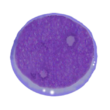The flow cytometric diagnosis of AML
From haematologyetc.co.uk
| 1. The immunophenotype of AML blasts will (generally) reflect their primitive nature |

The typical "primitive" morphology of blast cells is generally accompanied by signs of primitive immunophenotype
- Most often in AML typical features of immature cells will be found with: weak expression of CD45, together with expression of CD34 and/or CD117. Other markers may be useful in difficult cases (see Click for more detailed description)
- However in cases where blast cells show more differentiation their nature may be less clear. This is most frequently encountered in monocytic cases of AML or in APL (Click for a more detailed description)
| 2. The cases should express sufficient markers to allow myeloid lineage to be assigned |

Like Auer rods or granulation in morphology, particular immunophenotypic features support assignment to myeloid lineage
- Typical cases can generally be recognised by their expression of combinations of myeloid markers that have varying levels of specificity. These most often will include combinations of MPO, CD117, CD33 and CD13, although their relative specificity in AML diagnosis can vary and it is importat to ensure that criteria for myeloid-lineage assignment are met (see table for details)
- In cases with atypical maturation an extended marker panel may allow that differentiationto be identified, and may help to clarify myeloid lineage in difficult cases; however the specificity of these markers may be lower so care is required (see Table for details)
| 3. Are atypical features present? Should alternative diagnoses be considered? |

Difficult cases often arise where lineage may be unclear. Either because myeloid lineage cannot be confidently assigned or because markers of other lineage are present - in such cases it is important to consider possible alternative diagnoses
- The expression of "non-lineage" markers in AML is well recognised, and in many cases these should be simply regarded as "expected aberrancy" while others are associated with specific AML subtypes, these do not necessarily indicate mixed phenotype, but when these markers are detected then this requires specific consideration (Click here for further detail)
- Some features should give concern for mixed phenotype or alternative diagnosis. While these circumstances are infrequent, it is important that where immunophenotype is atypical then the criteria should be carefully reviewed (see the table below more detailed guidance).
| When to consder an amended lineage assignment The criteria below are brief and only indicate where concern should be raised, please see link (in blue) for full information. | |
|---|---|
| Mixed Phenotype Acute Leukaemia See: MPAL |
Consider MPAL if: There is sufficient evidence to assign myeloid lineage but the cells also express either a lineage-defining marker of T or B cells, or more than one lineage associated marker of T or B cells. |
| Acute Undifferentiated Leukaenmia See: AUL |
Consider AUL if: There is insufficient evidence to assign myeloid lineage, but there is expression of one myeloid-associated marker, and you cannot assign T-cell or B-cell lineage. I |
| Non-haematological malignancy See Non-haem |
Consider non-haematological malignancy if: Myeloid markers are expressed but not conclusice, CD45 expression is very weak, the presentation is atypical. |
| Early T-cell precursor ALL See: ETP-ALL |
The marker pattern is of a primitive T cell neoplasm with lineage-defining crieria, but there are also myeloid markers expressed |